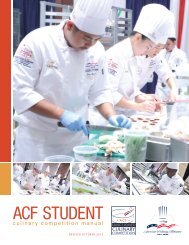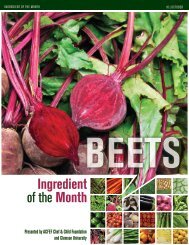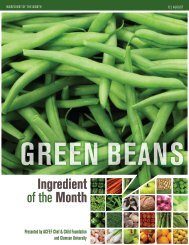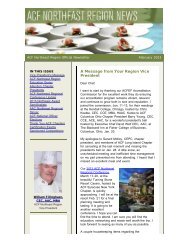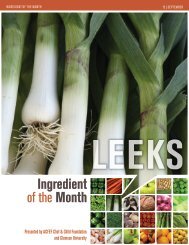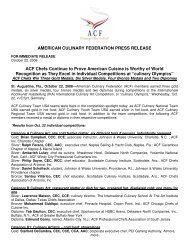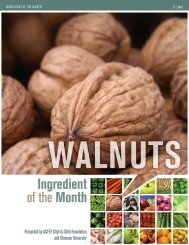Mushrooms - Clemson University
Mushrooms - Clemson University
Mushrooms - Clemson University
- No tags were found...
You also want an ePaper? Increase the reach of your titles
YUMPU automatically turns print PDFs into web optimized ePapers that Google loves.
INGREDIENT OF THE MONTH11 | OCTOBERMUSHROOMSIngredientof the MonthPresented by ACFEF Chef & Child Foundationand <strong>Clemson</strong> <strong>University</strong>
INGREDIENT OF THE MONTH11 | OCTOBERFound in nature, mushrooms are a spore-forming fungus.These fungi are used throughout all manners of cooking andgive dishes a “meaty” taste due to their high amino acid content.Early Greeks and Romans are thought to be among the originalmushroom cultivators. Today, China is said to be the largestproducer of safe-to-eat mushrooms. There are thousands ofvarieties of cultivated and wild mushrooms all over the world,with more than 3,000 in North America alone. They can be foundin fresh, dried, and even powdered form. Due to the fact thatmushrooms are not photosynthetic, they can grow on farms yearround.However, fall and winter are considered peak seasons.<strong>Mushrooms</strong> have long been revered as a powerful sourceof nutrients. Often grouped with vegetables, mushroomsprovide many of the nutritional attributes found in produce,as well as those found in meat, beans and grains.<strong>Mushrooms</strong> are low in calories, are fat-free, cholesterol-freeand are low in sodium, yet they provide important nutrientssuch as selenium, potassium, riboflavin, niacin and vitaminD. <strong>Mushrooms</strong> are also low in calories. It’s because of this,combined with their high nutritional content, that they are agreat, healthy food to eat.Healthy ingredient contributionB VITAMINS play an important role in the nervoussystem. Unlike most other vegetables, mushrooms are agood source of B vitamins, including riboflavin, niacin andpantothenic acid, which helps provide energy by breakingdown proteins, fats and carbohydrates.SELENIUM is a mineral that works as an antioxidantto protect body cells from damage that might lead toheart disease, some cancers and other diseases of aging.Many foods of animal origin and grains are good sourcesof selenium, but mushrooms are among the richestsources of selenium in the produce aisle, making them anespecially valuable source of selenium for vegetarians.ERGOTHIONEINE is a naturally occurringantioxidant that may help protect the body’s cells.COPPER is an important mineral because of its heartprotection properties. It helps make red blood cells thatcarry oxygen throughout the body. Copper also helpskeep bones and nerves healthy.POTASSIUM is an important mineral used in themaintenance of normal fluid and mineral balance, whichhelps control blood pressure. It also plays a role inmaking sure nerves and muscles, including the heart,function properly.BETA-GLUCANS, found in numerous mushroomspecies, have shown marked immunity-stimulatingeffects, contribute to resistance against allergies andmay also participate in physiological processes relatedto the metabolism of fats and sugars in the human body.Beta-glucans contained in oyster, shiitake and split gillmushrooms are considered to be the most effective.VITAMIN D helps build and maintain strong bones byhelping the body absorb calcium. It is available throughdiet, supplements and sunlight, which is why it is alsoreferred to as the “sunshine vitamin.” <strong>Mushrooms</strong> are theonly natural source of vitamin D in the produce aisle andone of the few non-fortified food sources.Varieties and usesThere are many types of mushrooms. Here’s a look at themost common varieties used in the food industry:• Beech: Beech mushrooms are petite, with either whiteor light-brown caps. They offer a crunchy texture, andhave a mild, sweet and nutty flavor that complementschicken and fish dishes.• Crimini: Crimini mushrooms, also known as “babybellas,” are similar in appearance to white buttonmushrooms, but have a tan cap coloring. They have afirmer texture and hearty taste that pairs well with beef,gamey meats and vegetables.• Enoki: Enoki are small mushrooms with long, spindly stemsthat are frequently used raw in salads and sandwiches.• Maitake: Maitake, or “hen of the woods” mushrooms,appear rippled and fan-shaped, without caps. Theyhave a distinct aroma and woody taste that adds a richmushroom flavor to any dish.• Oyster: Oyster mushrooms are velvety in texture and canbe gray, pale yellow or even blue. They have a light, meatyflavor that pairs well with meats, primarily steak or beef.• Portobello: Portobello mushrooms are a larger relativeof criminis, with brown caps that can measure up to sixinches in diameter. They can be grilled, broiled or roasted.Due to their large size and meat-like flavor and texture,they can be used as a vegetarian alternative to meat.• Shiitake: Shiitake mushrooms have brownish, broad,umbrella-shaped caps with tan gills and curved stems.They have a meaty texture that turns to a woody flavorwhen cooked. These mushrooms add a meaty flavor towhatever ingredients they are paired with.• White button: White button mushrooms representabout 90 percent of the mushrooms consumed in theU.S. Eaten alone, they have a mild taste, but this varietyblends well with just about any food.• Wild: Morels, truffles and chanterelles are prized wildvarieties of mushrooms; however, there are also thousandsof inedible and poisonous mushrooms that often resemblenon-poisonous ones. Therefore, it is important to onlypurchase wild varieties from a trusted retailer.
INGREDIENT OF THE MONTHStorageFresh mushrooms can be stored, unwashed, in therefrigerator for up to three days. Don’t wrap them inplastic; they’ll stay firmer placed in a single layer ona tray that is covered with a damp paper towel.11 | OCTOBERServing sizeAlthough the breakdown may fluctuate slightly accordingto the variety, in general, a half cup of raw white mushroompieces consists of 8 calories, 1.8 grams of protein, 0.1 gramof fat, 2 milligrams of sodium and no cholesterol.Contributions to this article were made by Darrin Sorenson.AMERICAN CULINARY FEDERATION180 Center Place WaySt. Augustine, FL 32095800.624.9458 | www.acfchefs.orgYield: 6 servings (serving size: 2 stuffed mushrooms)Ingredients:RECIPEMASHED POTATO-STUFFED MUSHROOMS WITH MUSHROOM SAUCECooking spray, as needed1 (16-oz.) package large(2-inch diameter) whitemushrooms, stemmed1 lb. small white potatoes¼ cup buttermilk2 garlic cloves, minced1 T. chopped chives¼ t. salt1 T. unsalted butter1 T. olive oil1 (8-oz.) packaged babyportabella mushrooms,sliced1 cup low-sodium beef broth2 T. cold water1 T. all-purpose flour1 T. red wine vinegar¼ t. salt (optional)¼ t. freshly ground blackpepperMethod:Preheat oven to 400°F. Coat 11x7-inch baking dish withcooking spray. Arrange white mushrooms in dish, cap sidesdown. Bake mushrooms for 15 minutes. Remove from oven;set aside. Bring large pot of water to a boil over high heat. Addpotatoes; boil for 10-15 minutes or until tender. Drain; mash inlarge bowl. Mix mashed potatoes with buttermilk, garlic, chivesand salt until smooth. Spoon into mushroom caps. Bake for15 minutes or until mushrooms are tender. Make sauce: Meltbutter and olive oil in saute pan over medium-high heat. Addportabella mushrooms; cook 3-5 minutes, stirring occasionallyuntil softened. Add beef broth; simmer until slightly reduced,about 5 minutes. In small mixing bowl, combine coldwater and flour; whisk until smooth. Stir in flour mixture.Add vinegar; season with salt and pepper. Simmer untilthickened, about 1 minute. Pour sauce over mashedpotato-stuffed mushroom caps. Serve immediately.Nutrition InformationCalories: 140Fat: 5gSat. Fat: 2gCarbs: 19gFiber: 1gProtein: 5gVitamin A: 2%Vitamin C: 30%Calcium: 2%Iron: 6%This recipe was tested by <strong>Clemson</strong> <strong>University</strong>’s Culinary Nutrition Undergraduate Student Research Group.



